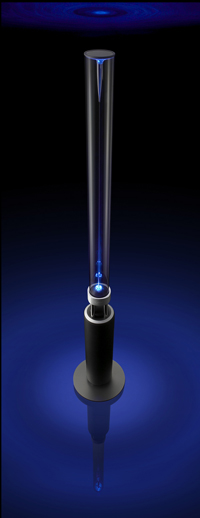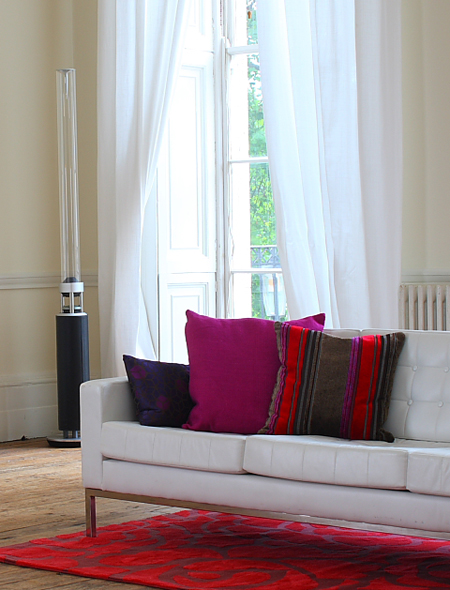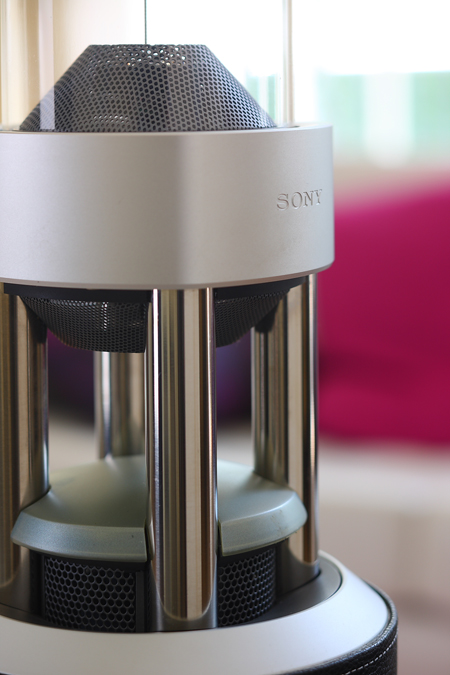Sound All Around

 The Sountina is a self-powered, 3-way speaker with a claimed frequency response of 50Hz to 20kHz (no tolerance given), reproduced by a 5-inch woofer, 2.75-inch midrange, and 39-inch tweeter. What? Wait a minute—a 39-inch tweeter? Well, yes, in a way. The tweeter is actually a 1-meter-long glass tube that radiates the high frequencies in a 360-degree cylindrical pattern.
The Sountina is a self-powered, 3-way speaker with a claimed frequency response of 50Hz to 20kHz (no tolerance given), reproduced by a 5-inch woofer, 2.75-inch midrange, and 39-inch tweeter. What? Wait a minute—a 39-inch tweeter? Well, yes, in a way. The tweeter is actually a 1-meter-long glass tube that radiates the high frequencies in a 360-degree cylindrical pattern.
The tube is driven by an actuator at its base, which vibrates in a direction parallel to the tube's axis, sending compression waves along its length. Amazingly, this launches sound waves from the entire length of the tube perpendicular to its axis in a cylindrical pattern.
The woofer and midrange are conventional cone diaphragms mounted vertically—woofer pointing down near the bottom and midrange pointing up below the glass tube—so their sound emanates in a 360-degree pattern as well. Also in the speaker's base is a power amp along with stereo analog and digital audio inputs.
Wait another minute—a single powered speaker with stereo audio inputs? What's up with that? According to Sony, only one speaker is needed in a room because it delivers sound over 360 degrees. It even has a Wide mode, which, according to the manual, creates a "wider sound image," whatever that means. Regardless of what this Wide mode does, a single speaker cannot reproduce a stereo soundfield, so it seems that the Sountina is intended for ambience and background applications, not critical listening, since it must mix the two signals together.

Another fascinating aspect of the Sountina is how the intensity of the speaker's sound behaves at different distances. For a conventional point-source driver, such as a cone or dome, moving twice as far away causes the intensity to drop 6dB in open air. By contrast, the intensity from a line-source driver, such as the Sountina's glass-tube tweeter, falls by only 3dB at twice the distance. Thus, at different distances, the balance between the tweeter and midrange/woofer cones changes. These rules don't apply in a closed space with reflective walls, so it's probably not as big a deal as it sounds, though it does give me pause.

A big part of Sony's goal with the Sountina is making a design statement. One element of that effort is the thin wire that runs down the center of the tube, which suggests the string of a violin or other such musical instrument but has no functional purpose. In addition, there's a dimmable light at the bottom of the tube that can be set to different colors, and a leather sheath can enwrap the speaker's base or not as befits the décor.

The Sountina is available in Japan, Europe, Russia, the United Arab Emirates, Taiwan, Brazil, Panama, and Chile, but not the US. The price tag is ¥1,050,000, which converts to just over $11,000 as of this writing—and that's for a single speaker.

I'm quite curious about how it would sound to feed the left and right channels of a stereo source separately to two Sountinas or, even better, multichannel home-theater audio to five or seven of them. Would the 360-degree radiation pattern be more enveloping than conventional speakers, or would the reflections from the walls turn the sound to mush? I suspect the latter, but it sure would be fun to find out.
- Log in or register to post comments































































